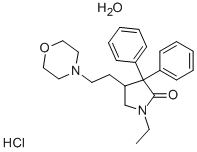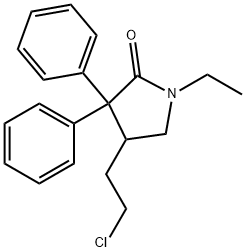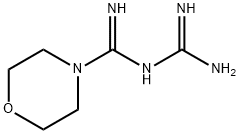BD3282345
DoxapramHydrochlorideMonohydrate , 98% , 7081-53-0
Synonym(s):
1-Ethyl-4-[2-(4-morpholinyl)ethyl]-3,3-diphenyl-2-pyrrolidinone monohydrochloride monohydrate;Doxapram hydrochloride monohydrate
CAS NO.:7081-53-0
Empirical Formula: C24H30N2O2.ClH.H2O
Molecular Weight: 432.99
MDL number: MFCD09954698
| Pack Size | Price | Stock | Quantity |
| 5g | RMB592.80 | In Stock |
|
| others | Enquire |
Update time: 2022-07-08
PRODUCT Properties
| Melting point: | 217-219° |
| storage temp. | Sealed in dry,Room Temperature |
| solubility | Soluble in water, in alcohol and in methylene chloride. |
| form | Solid |
| color | White to off-white |
| InChI | InChI=1S/C24H30N2O2.ClH.H2O/c1-2-26-19-22(13-14-25-15-17-28-18-16-25)24(23(26)27,20-9-5-3-6-10-20)21-11-7-4-8-12-21;;/h3-12,22H,2,13-19H2,1H3;1H;1H2 |
| InChIKey | ZOMBFZRWMLIDPX-UHFFFAOYSA-N |
| SMILES | C1(=O)N(CC)CC(CCN2CCOCC2)C1(C1C=CC=CC=1)C1C=CC=CC=1.Cl.O |
Description and Uses
Doxapram is a central respiratory stimulant. It increases respiration and phrenic nerve activity in anesthetized cats at a dose of 1.0 mg/kg. Doxapram acts through carotid chemoreceptors, lacking activity in anesthetized cats following carotid denervation. Formulations containing doxapram have been used to increase respiration in patients with chronic pulmonary disease, respiratory depression induced by drug overdose, and to stimulate deep breathing post-anesthesia.
antibacterial
Safety
| Symbol(GHS) |  GHS06 |
| Signal word | Danger |
| Hazard statements | H301 |
| Precautionary statements | P301+P330+P331+P310 |
| RIDADR | UN 2811 6.1 / PGIII |
| HS Code | 2934990002 |
| Toxicity | LD50 orally in rats: 261 mg/kg (Goldenthal) |


![2-Pyrrolidinone, 1-ethyl-4-[2-[(2-hydroxyethyl)amino]ethyl]-3,3-diphenyl-](https://img.chemicalbook.com/CAS/20180629/GIF/1688-76-2.gif)



